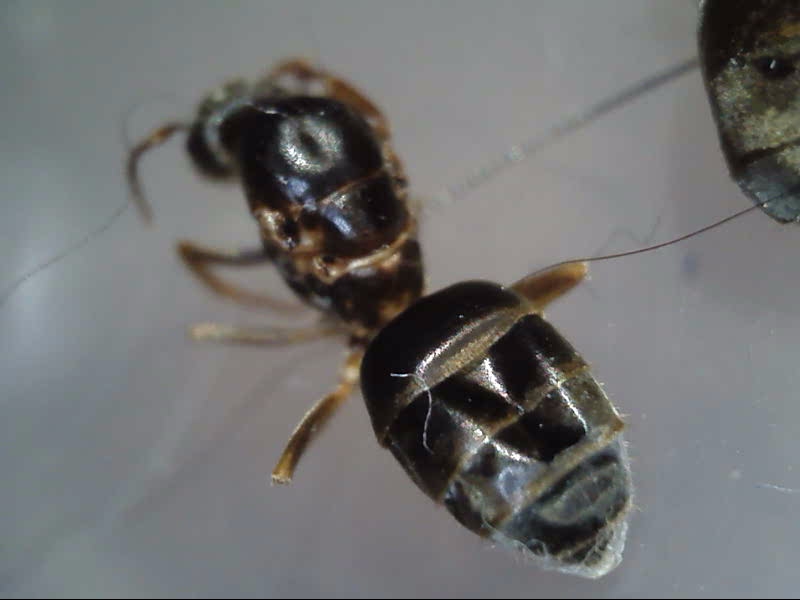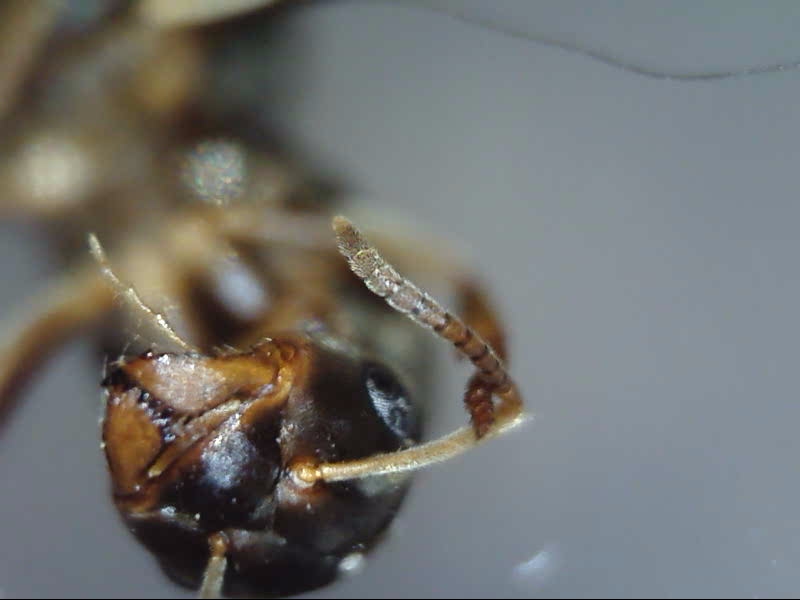
parasitic lasius queen? r/ants
decumbent pubescence on the anterior (vertical) surface of first gastral tergite relatively sparse, distance between hairs not shorter (usually longer) than the hairs length Queen - eyes with somewhat longer hairs, length of the longest ones ≥ 0.040 mm Queen - eyes with somewhat shorter hairs, length of the longest ones ≤ 0.035 mm

Lasius niger FREE Queen Ant (Black Garden Ant) AntLab
Length: 3.8-5.5 mm Mackay and Mackay (2002) - The workers of this species are yellow or pale brown ants, which have small eyes (35 - 65 ommatidia). The length of the longest hairs on the posterior half of the first gastral tergum (excluding those along the posterior strip) are less than ½ the maximum width of the posterior tibia at mid-length.

Lasius fuliginosus queen + Lasius umbratus (group) 20190815 005812
The black garden ant ( Lasius niger ), also known as the common black ant, is a formicine ant, the type species of the subgenus Lasius, which is found across Europe and in some parts of North America, South America, Asia and Australasia.
Lasius umbratus (queen) photo Tom Murray photos at
Colony form: Possibly polygynous but usually only has one queen. Colony size: 12.000-20.000 workers. Colony age: 5-15 years. Founding: Fully claustral. Workers: Monomorphic. Nesting: These ants dig nests into dirt and often burrow quite deep. (at least a foot). They also love living under stones.

Lasius queens Formigas, Insetos, Formiga
Key to Nearctic Acanthomyops queens Key to Nearctic Acanthomyops males There is also a somewhat outdated (1955) and restricted (no Nearctic Acanthomyops queens and males): Key to Lasius queens and males See images of species within this genus Keys including this Genus Key to Ant Genera of the Navajo Reservation

woodland fuzzy ant queen Lasius americanus
Lasius niger queen with workers and brood. Photo: Lennart Tange. Appearance of Lasius niger. Worker: Length: 2,0-5,0 millimeters. Dark brown/black with greyish tones. The thorax is lighter than the rest of the body. Legs and antennas (including the first long antenna segment by the head and tibia*) is generously covered with straight protruding.

Lasius crypticus Lasius Queen ID Gallery Ants & Myrmecology Forum
Lasius, Fig. 1 Examples of four Lasius species to show the relatively generalized body form. ( a) L. neoniger queen, Illinois, USA. ( b) L. americanus worker, Illinois, USA. ( c) L. latipes queen, Illinois, USA. ( d) Two-winged females (bigger), one-winged male, and workers of L. nearcticus, New York, USA. (All photos © Alex Wild) Full size image

Lasius umbratus queen? YouTube
Mackay and Mackay (2002) - This is a small, dark brown or black species with relatively large eyes (12-14 ommatidia in maximum diameter). The scape has few (less than 5) or no erect hairs (except at apex). The penultimate tooth is about the same size as the adjacent teeth (other 2 basal teeth).

Lasius flavus queen in adult colony YouTube
The black garden ant (Lasius niger) is the most common European ant species . Lasius niger colonies can reach in size up to around 40,000 workers but 4,000-7,000 is around average. A Lasius niger queen can live up to around 15 years and it has been claimed that some have lived for 30 years.

Lasius fuliginosus queen (HD) YouTube
It is a common species in Greece where it is known from all provinces. In Achaia and Aetolia-Acarnania, it has been observed in rural sites in tourist resorts, mixed and fir forests and mountain pastures. Nests were located under stones. (Borowiec & Salata, 2021) At a Glance • Limited invasive Identification

Lasius Flavus Queen Ant + Workers HighTechAnts
Lasius fuliginosus, also known as the jet ant or jet black ant, is a species of ant in the subfamily Formicinae . Distribution This species has a wide distribution in Europe and Asia, from Portugal and Ireland in the west, Finland in the north to Italy in the south, and eastwards to Korea and Japan.

Lasius Queen ubicaciondepersonas.cdmx.gob.mx
Abstract This datasheet on Lasius neglectus covers Identity, Overview, Distribution, Dispersal, Diagnosis, Biology & Ecology, Natural Enemies, Impacts, Prevention/Control, Further Information. Identity Preferred Scientific Name Lasius neglectus Van Loon, Boomsma & Andrásfalvy, 1990 Preferred Common Name invasive garden ant Pictures

Lasius flavus queen a photo on Flickriver
Abstract. 1 . The yellow subterranean ant Lasius flavus is generally considered to have a single queen in mature nests. Yet, many anecdotal observations have suggested that the conspicuous earth mounds of this ant may, at least occasionally, contain several queens and their offspring.

Lasius Queen ubicaciondepersonas.cdmx.gob.mx
Lasius Brevicornis Ant Colony Queen 15-30 workers & VERY LARGE PILE OF MATURE BROOD Colony size: Varies and depends on connectivity with other nests but from around 4000/5000 to around 230.000 workers Colony age: up to 25 years founding: Claustral Workers: Monomorphic As with most Lasius species, colonies grow fast. So ensure you have plans for a nest and outworld before the test-tube set-up.

AntsRus live queen ant Live ants Lasius niger Queen with 510 workers
Lasius is a genus of formicine ants. The type species for this genus is the black garden ant, Lasius niger.Other major members, which live in drier heathland, are the cornfield ant, L. neoniger, and L. alienus.Other species include the temporary social parasites of the L. mixtus group and the hyper-social parasite Lasius fuliginosus. Lasius flavus is also a commonly seen species, building.

Lasius crypticus Lasius Queen ID Gallery Ants & Myrmecology Forum
Lasius americanus is incredibly resilient, active, fast growing, aggressive, recruits very effectively and utterly dominates areas it managed to establish itself in, wiping out other ant colonies that happen to end up inside it's territory with great efficiency. This species is often confused with L. neoniger, pallitarsis, and crypticus.